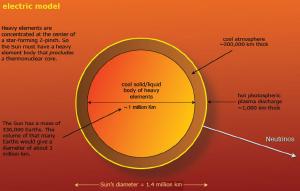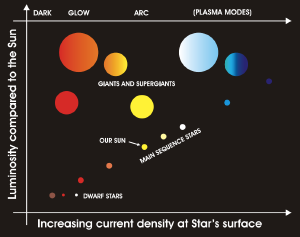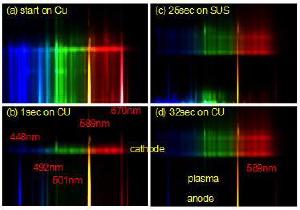Blog
Just So Story
27 January 2018
 Everything is Electric
Everything is ElectricIf there’s one thing I’ve learned by writing about science, it’s this: alternative physics folks love an argument. They particularly love if you make a statement about their model that they think is wrong. Then they can focus on your error rather than defending the merits (or lack thereof) of their model. This is particularly true of some of the more popular fringe models such as the electric universe, planet Nibiru, or the flat Earth. Rather than a single work by a lone genius, these models have dozens of books and websites, hundreds of videos, and a myriad of often contradictory claims. If you aren’t absolutely accurate about every minor detail of their model, if you haven’t read and fully understood everything about their model, then may God have mercy on your lying little soul. Case in point: the great neutrino debate of 2014 – 2018.
While I don’t generally focus on alternative science models on this blog, I do like to talk about them from time to time. It’s a great way to show how we test scientific claims based on the evidence at hand. Fringe models aren’t rejected because they seem crazy. They’re rejected because the evidence doesn’t support them. So back in 2013 I started getting comments claiming astrophysics is wrong, and the truth is revealed in a new model called the Electric Universe, or EU for short. Over the next several months these comments got increasingly more common, so I figured I’d start looking into the model.
It’s a bit of an odd history. It’s origins can be traced back to The Electric Universe, published in 2007 by physicist Wallace Thornhill and comparative mythologist David Talbot. The broad claim is that traditional astrophysics is wrong, particularly in the way it deals with gravity, or prioritizes gravity in its models. As an alternative it presents a model where gravity plays a minor role. Planets, stars and galaxies are guided and even formed through electromagnetic forces. The universe is electric, not gravitational.
 Thunderbolts
ThunderboltsNow it seems odd that a comparative mythologist would co-author a book on astrophysics, until you realize that The Electric Universe is a sequel to the 2005 book Thunderbolts of the Gods by the same authors. In this book the authors claim that many of the myths found in ancient civilizations were based on real astronomical events. As they write in the first chapter, after more than thirty years spent studying ancient history they have come to the shocking conclusion
The evidence suggests that only a few thousand years ago planets moved close to the earth, producing electrical phenomena of intense beauty and terror. Ancient sky worshippers witnessed these celestial wonders, and far-flung cultures recorded the events in the great myths, symbols, and ritual practices of antiquity.
They also write:
We contend that humans once saw planets suspended as huge spheres in the heavens. Immersed in the charged particles of a dense plasma, celestial bodies “spoke” electrically and plasma discharge produced heaven-spanning formations above the terrestrial witnesses. In the imagination of the ancient myth-makers, the planets were alive: they were the gods, the ruling powers of the sky.
That’s some pretty trippy stuff, but it seems to have roots in Immanuel Velikovsky’s 1950 book Worlds in Collision, where he claimed Venus was ejected from Jupiter thousands of years ago, passed by Earth changing its orbit and axial tilt, and the resulting geological catastrophes were recorded by early civilizations, such as Athena (not Venus, but close enough) springing out of the head of Zeus (Jupiter).
In other words, the electric universe began as a just-so story. The stories of ancient civilizations must be true, so the authors toss out established science to create a new field of astrophysics. One that can move Heaven and Earth to match their theory. But regardless of its origins, by 2014 the EU model was promoted as a legitimate scientific model. One based not on mythology, but on modern astronomical data. One that mainstream astronomers couldn’t accept because it would overturn their cherished cosmology.

Given its history, I could have just mocked the EU model as some kind of Chariots of the Gods kind of nonsense. But I wanted to give the model a fair shake. What are the actual claims of EU, and how do they compare to actual data? Weeding through various websites and videos can be a challenge, but fortunately EU had a great resource for beginners. A Beginner’s View of Our Electric Universe, by Tom Findlay. It was revised in 2013, making it reasonably up to date, and it was highly praised by Thornhill and other leading supporters of EU. As an extra bonus, the author made a PDF version freely available to the public, so anyone can check out the claims of EU for themselves. With this and other resources I was ready to write my post.
There’s a lot of strange claims made in the EU model, but one of the strangest is that stars are not powered by nuclear fusion. Findlay’s book reiterates this point numerous times, arguing that fusion does not occur in stars. In chapter 4, Findlay writes:
We will be returning to the idea of nuclear fusion-powered stars later to delve into why this, in fact, is not the way the Sun works and to take a close look at how all stars actually do work, electrically of course.
Image from Findlay’s book, showing the relation between current flow and stellar type.
 Tom Findlay
Tom FindlayIn Chapter 6, Findlay explains that stars shine due to cosmic electric currents flowing through a star’s plasmasphere. Rather than nuclear fusion, stars are powered like an arc light. There are two big problems with this idea. One is that without nuclear fusion, the Sun would produce no neutrinos, but solar neutrinos have long been observed. The second is that plasma arc light doesn’t emit light in a continuous thermal spectrum, whereas the observed spectrum of the Sun is a thermal blackbody. Naturally, I pointed this out it my post, Testing the Electric Universe. And thus I sparked the fury of EU fans everywhere.
Their biggest complaint was that EU does not say fusion doesn’t occur. Which was evidence not only of my ignoble behavior, but also that scientists in general can’t be trusted. It doesn’t matter than Findlay clearly claims fusion doesn’t occur at all. Since other versions of EU say it might, I’m a lying liar. A couple of folks even tried to get me fired from my university position over this. To this day EU fans continue to demand I explain my unethical behavior, despite the fact that it’s been debated ad nauseam in the comments.
Of course the problem is that there isn’t just one EU model at this point, there are several conflicting versions of them. To my best current understanding, some EU models say fusion doesn’t occur at all, some EU supporters claim neutrinos don’t even exist, and some claim fusion occurs near stellar surfaces, but (as far as I know) all claim fusion does not occur in stellar cores. Again, to my understanding, if core fusion were shown to be valid, it would overturn the electric star claims of EU models, and thus most of EU in general.
If fusion occurred near a Sun’s surface, it would produce neutrinos, so the mere detection of solar neutrinos is consistent with both surface and core fusion models. However, we can do much more than detect solar neutrinos. We now have measurements of both the types (flavors) of neutrinos and their energy levels. We know the rate at which solar neutrinos are generated at various energy levels. What we find is that the energy of neutrinos follows a thermal distribution consistent with the thermal distribution we expect in the core (that is, produced by intense heat and pressure). Fusion produced by electromagnetic plasmas would have a different spectrum, which isn’t observed in solar neutrinos. We know this because we use particle accelerators (electromagnetic plasmas) to produce neutrinos in the lab. More recently we have finally detected neutrinos from the fundamental proton-proton collisions in the Sun’s core, which is consistent with core fusion.
Even if EU’s surface fusion model could be tweaked to mimic core fusion, there were still be the issue of high energy gamma rays. Any fusion of light elements produces not only neutrinos, but high energy photons (gamma rays). We’ve observed the Sun with gamma ray telescopes, and found no steady stream of gamma rays coming from the Sun. We sometimes observe bursts gamma rays coming from very intense solar flares, but this is not consistent with the electric Sun claims. The lack of observed gamma rays is consistent with the core fusion model. Gamma rays are produced in the solar core via fusion, but the photons soon collide with other nuclei in the core, transferring energy to the nuclei to generate heat. Thus the Sun is thermally heated through these gamma rays, which lose most of their energy before escaping the Sun.
 Ogawa Giken
Ogawa GikenSince the Sun is heated internally through nuclear fusion, its surface emits light with a thermal spectrum distribution. This is known as blackbody radiation. We see this effect in lots of things from heated metal to stars. Objects that have (close to) a blackbody spectrum produce their light through internal heat rather than electron band gaps and such. This is why if you look at light from an incandescent light bulb you will see a smooth rainbow (thermal light), but if you look at a fluorescent light or LED light through a prism you will see specific colors (non-thermal light). If sunlight were produced by surface fusion in the low-density outer layer of the Sun, the light produced wouldn’t be a thermal blackbody. Now, you could argue for some unspecified process that takes the light produced by surface fusion and heats the (more dense) photosphere to produce a thermal spectrum. That would be consistent with the sunlight we observe, because regardless of how the photosphere is thermally heated (core or surface) the spectrum would be pretty much the same.
But there’s a problem with a surface-heated photosphere model. If the Sun is surface heated rather than core heated, the surface should be hotter than the interior. Some EU folks actually claim this. But we know from observations that the deeper layers of the photosphere are hotter than the surface layer. So surface heating can’t be right given standard physics. To get around this, some folks such as Pierre-Marie Robitaille now claim that the blackbody law isn’t valid, and that the surface of the Sun is some kind of liquid metal. It gets pretty strange beyond that point. Basically you have to start tossing out well-proven physics left and right just to cobble together a model that can match observation, when the core fusion model already matches observation extremely well and in multiple ways.
As I wrote in 2014, the Electric Universe model is contradicted by observational evidence. Neutrinos or no, EU is provably wrong. That fact hasn’t changed over the years, and isn’t likely to.
If you’re an EU fan reading this, it’s probably because you tried to argue about my 2014 post, and I sent you this link in reply. Congratulations on making it to the end. It’s been four years since I wrote that post, and I’ve grown tired of constantly being asked to rebut your just-so story.